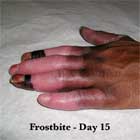|


|
synonyms:Frostbite
Frostbite ICD-10
Frostbite ICD-9
- 991.0 Frostbite of face
- 991.1 Frostbite of hand
- 991.2 Frostbite of foot
- 991.3 Frostbite of other and unspecifiec sites
Frostbite Etiology / Epidemiology / Natural History
- Frostbite is a specific type of cold injury that occurs as a progression towards actual freezing of all tissues.
Frostbite Anatomy
Frostbite Clinical Evaluation
Frostbite Xray / Diagnositc Tests
Frostbite Classification
- 1st Degree: mottled, cyanotic painful and burning
- 2nd Degree: blistering, deeply erythematous, painful, burning, swollen
- 3rd Degree: hemorrhagic, blistering, necrotic skin and underlying tissue, swollen, severe aching and throbbing.
- 4th Degree: anesthetic area, complete necrosis of skin and bone, not swollen
Frostbite Treatment
- In the acute phase of frostbite (less than 24 hours after injury), the initial treatment includes rewarming of the entire body prior to transportation of the patient to the hospital. Rapid warming of the extremity is then recommended.
- A frozen foot should be placed in a circulating water bath at 104 degrees F (40.0 degrees C) for 15 to 30 minutes.
- Analgesics may be necessary during the rewarming phase.
- Consider an early phase Tc-99n scintiscan, intravenous or intra-arterial tissue plasminogen activator (0.15mg/kg bolus and continuing at 0.15mg/kg/hr up to 100mg in 4-6hours), therapeutic heparin for 3-5 days followed by warfarin and ibuprofen. (Twomey JA, J Trauma 2005;59:1350-1355)
- Additional treatment includes appropriate splinting, tetanus prophylaxis, analgesia, and antibiotics. A rewarmed body part is very susceptible to further injury; therefore, it should be protected from any additional pressure or chance of refreezing.
- Because severe swelling may occur with the rewarming of extremities, the patient must be monitored for signs or symptoms of compartment syndrome.
- Surgery shoulde be delayed (@90 days) to assess areas of revitilization vs mummification.
- No rewarming should be done if there is risk of repeat freezing. Freeze/thaw cycles cause increased damage. Do not rub frostbitten areas.
- Frostbite Prevention: the most reliable method to reduce the risk of frostbite is to reduce thermal heat loss. Wear protective socks and shoes. Moisture reducing socks.
Frostbite Associated Injuries / Differential Diagnosis
Frostbite Complications
Frostbite Follow-up Care
Frostbite Review References
- McCauley RL, Hing DN, Robson MC, et al: Frostbite injuries: A rationale approach based on the pathophysiology. J Trauma 1983;23:143-147.
- Foray J: Mountain frostbite: Current trends in prognosis and treatment (from results concerning 1261 cases). Int J Sports Med 1993;13:S193-196.
- Twomey JA, J Trauma 2005;59:1350-1355
- Seto CK, Clin Sports Med 2005;21:695
|